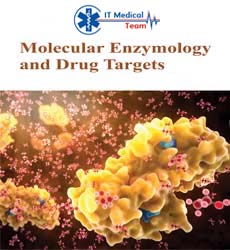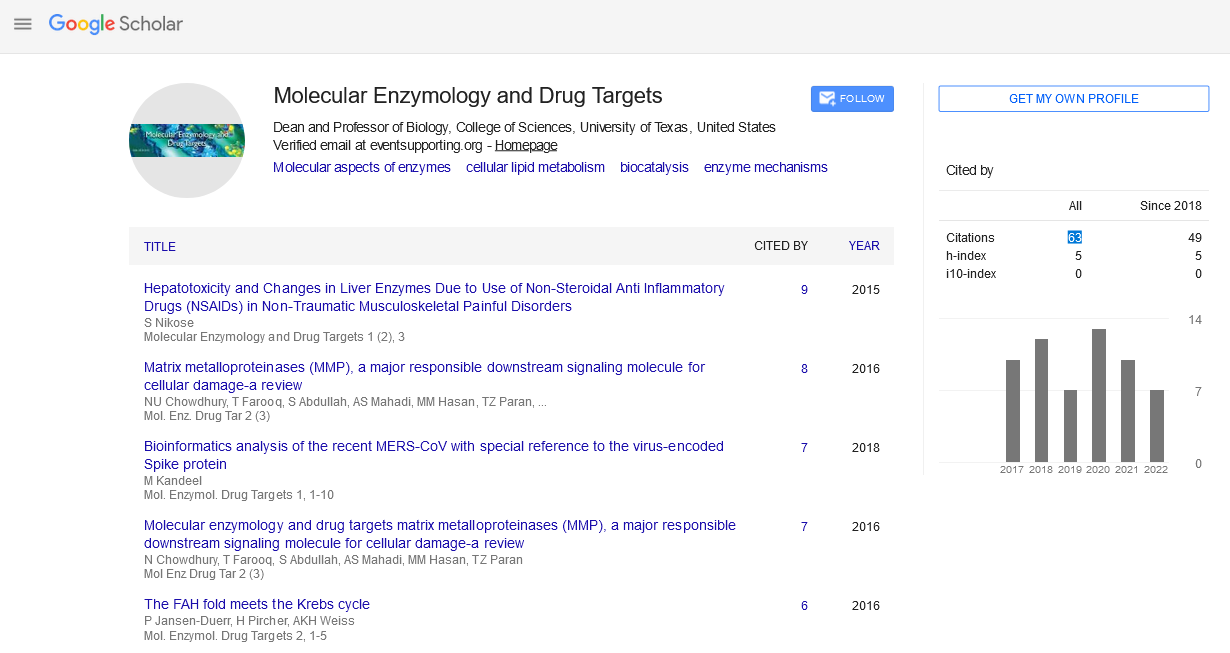Pundir CS* and Vishakha Aggarwal
Department of Biochemistry, M.D.University, Rohtak, Haryana, India
- *Corresponding Author:
- Pundir CS
Department of Biochemistry
M.D.University, Rohtak 124001
Haryana, India
Tel: 01262- 393070
Email: pundircs@rediffmail.com
Received date: June 28, 2016; Accepted date: September 19, 2016; Published date: September 26, 2016
Citation: Pundir CS (2016) Are Aggregates of Enzyme Molecules More Effective than Individual Enzyme Molecules? Mol Enz Drug Tar 2:2
Copyright: © 2016 Pundir CS, et al. This is an open-access article distributed under the terms of the Creative Commons Attribution License, which permits unrestricted use, distribution, and reproduction in any medium, provided the original author and source are credited.
Short Communication
Enzymes are well known as specialized globular proteins, which catalyses the biochemical reactions without being consumed in the reaction. These enzymes are synthesized in living cells. They function both in vivo and in vitro. When these enzymes are dissolved in buffer, their diameter is around 10 nm. However, when these molecules are made aggregated by desolvation method using ethanol in the nanoscale i.e., 10-200 nm, they are called enzyme nanoparticles (ENPs). These ENPs exhibit their unique optical, electrical, electronic, thermal, chemical and catalytic (ability to facilitate electron transfer) properties beside increased surface area. ENPs are glutaraldehyde cross linked and functionalised by treating with reagents like cysteine/ cysteamine dihydrochloride. Thus, these ENPs are immobilized covalently onto the polycrystalline Au electrode through Au-S- bond. This immobilized ENPs technology has opened a new area for enzyme sensors, biomedical devices and diagnostics to improve their analytic performance. Firstly, ENPs of horse radish peroxidase (HRP) with a diameter of 100 nm (consisting 1000 cross linked enzyme molecules, each of 6 nm in diameter) were prepared and characterized by UV spectro-scopy [1]. These were white in colour and showed absorption peak at 280 nm like free/ natve enzyme molecules. Thereafter, ENPs of few enzymes such as glucose oxidase (GOx), cholesterol oxidase (ChOx), uricase and cholesterol esterase (ChE) were prepared, which measured 117, 100-200, 100 and 35-57 nm in diameter respectively. These were characterized by UV and FTIR spectroscopy and employed in construction of improved amperometric biosensors for measurement of glucose, total cholesterol and uric acid in biological samples, respectively [2-6].
Although, the most popular method for formation of ENPs is desolvation, the other method includes emulsification, coacervation, cross linking in water in oil emulsion. The shape and sizeof these ENPs as revealed by their transmission electron microscopic (TEM) images are spherical with diameter in the range 100-200 nm. These ENPs show their characteristic absorption peaks in UV at 230, 235, 280 nm and FTIR spectra. ENPs have been immobilized onto artificial membrane through adsorption or metal electrode (Au/Pt) through covalent coupling.
Immobilized ENPs have shown increase in optimum pH compared to native/free e.g. from pH 5.5 to 6.0 for GOx and ChOx, and 8.0 to 8.5 for uricase [7], The amperometric biosensor based on ENPs exhibited better analytic performance in terms of increased optimum temperature ( from 35 to 450 C for GOx, 30 to 400 for uricase and 35 to 450 C for ChOx and ChE ) decreased response time (from 120 to 60s for GOx, 300 to 8s for ChOx, 300 to 7s for uricase and 300 to 5s for ChOx and ChE ) wider working range (from 1.0-13.8 to 0.056-1.39 mM for GOx, 1.0-6.4 to 0.69-38.88 for ChOx, 1.0-1.5-0.005-0.8 mM for uricase) and lower/decreased limit of detection (LOD) (from 1.0 to 0.1 mg/dl for ChE and ChOx, 160 to 0.005 mM for uricase), increased reusability (from 50-100 to 150-180-200 times for GOx, ChOx and uricase respectively) and increased/higher storage stability as compared to those based on native/free enzyme (Half life from 60 to 90 days for ChOx and 90 to 210 days for uricase) compared to those based on native enzyme [6,7].
ENPs have been employed in construction of amperometric biosensors for measurement of H2O2, glucose, free and total cholesterol and uric acid in biological fluids, which is essential in the diagnosis of treatment of various diseases [7]. The use of ENPs in place of native enzyme in construction of amperometric biosensor have not only simplified the construction of bio-nanosensors but led to their better analytic performance compared to the native enzyme sensors. A number of enzymes have been used as therapeutic agent/drug in long term treatment of various diseases such as asparaginase and glutaminase for leukemia, collagenase f
or skin disease, hyaluronidase for heart disease, oxalate oxidase for urinary stone disease, uricase for gout and trypsin for inflammation [8]. The ENPs of these enzymes are expected to provide better results than the native enzymes [7].
17769
References
- Liu G, Lin Y, Ostatna V, Wang J(2005)Enzyme nanoparticles-based electronic biosensor. ChemCommun 27:3481-3483.
- Sharma S,Shrivastav A, Gupta N,Srivastava S(2011). Amperometric biosensor: increased sensitivity using enzyme nanoparticles. IntConf Nano Biosensors IPCBEE 2:24-26.
- Kundu N, Yadav S, Pundir CS(2013) Preparation and characterization of glucose oxidase nanoparticles and their application in dissolved oxygen metric determination of serum glucose. J NanosciNanotechnol 13:1710-1716.
- Chawla S, Rawal R, Sonia, Ramrati, Pundir CS(2013) Preparation of cholesterol oxidase nanoparticles and their application in amperometric determination of cholesterol. J Nanopart Res 15:1934-1943.
- Chauhan, N, Kumar A, Pundir CS(2014) Construction of an uricase nanoparticles modified au electrode for amperometric determination of uric acid. App BiochemBiotechnol 174:1683-1694.
- Aggarwal V, Malik J, Prashant A,Jaiwal PK, PundirCS(2016) Amperometric determination of serum total cholesterol with nanoparticles of cholesterol esterase and cholesterol oxidase. Anal Biochem 500:6-11.
- Pundir CS(2015) Enzyme nanoparticles: Preparation,characterisation,properties and applications.Elsevier. pp:1-64.
- Dahiya T, Pundir CS (2013) in vivo oxalate degradation by liposome encapsulated oxalate oxidase in rat model of hyperoxaluria. Indian J Med Res 137:136-141.





